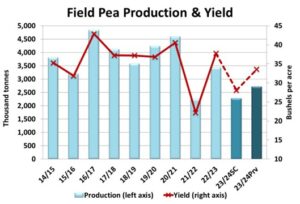Pulse Market Insight #241 OCT 27 2023 | Producers | Pulse Market Insights
Crop Size Uncertainty
The western Canadian pulse harvest was finished weeks ago, but there are still plenty of questions about how well (or poorly) crops performed in 2023. There’s always some uncertainty about the exact yields but this year, the question marks seem to be bigger than usual. One reason is the extreme variability in results, and we’ve heard everything from “disastrous” to “monstrous”. Trying to figure out an average yield for the prairies or even a single province is a challenge.
Back in mid-September, StatsCan released a set of yield estimates based on computer models and vegetation images. Since then, both Alberta Ag and Sask Ag have also issued yield estimates based on observations from a network of people, with their final crop reports released in mid-October. In some cases, there are large differences between StatsCan and the provincial crop reports.
For peas, the StatsCan yields were well below estimates from the provincial crop reports. According to StatsCan, the pea yield in Alberta was 27.3 bu/acre while Alberta Ag had yields pegged at 35.2 bu/acre. In Saskatchewan, StatsCan was at 27.2 bu/acre while the last estimate from Sask Ag was at 31.4 bu/acre. These are large differences and have a sizable effect on the crop size, depending which yield is closer to reality.

Using the StatsCan yields would mean a 2023 pea crop of 2.27 mln tonnes, in line with the drought reduced crop of 2021. Plugging in the provincial crop report yields would result in a crop of 2.72 mln tonnes. While that’s still at the lower end of recent history, it’s almost 450,000 tonnes more than the StatsCan-based crop. And in a year when some export demand is feeling a bit soft, those tonnes could make the market feel “heavier”, more so for yellows than greens.
Lentil yield estimates aren’t available from Alberta Ag but in Saskatchewan, the provincial crop report showed a yield of 1,101 lb/acre, higher than StatsCan’s estimate of 931 lb/acre. While that doesn’t seem like a big change, if we compare the results from those two yields, there is a meaningful difference.

Based on the lower StatsCan yield, the 2023 lentil crop would work out to 1.54 mln tonnes, very close to 2021 production. The higher output using the Sask Ag yield would be 1.78 mln tonnes; still not huge or heavy but would provide a bit more breathing room for processors and exporters.
These larger crop estimates from Alberta Ag and Sask Ag could be one reason why prices, especially for yellow peas and red lentils, haven’t been as strong as some people were expecting this fall. Of course, there have also been developments in pea and lentil demand that have caused quieter export business, at least in the short-term. It’s important to remember though that we’re just finishing up the first quarter of 2023/24, with three quarters left to play.
Pulse Market Insight provides market commentary from Chuck Penner of LeftField Commodity Research to help with pulse marketing decisions.
